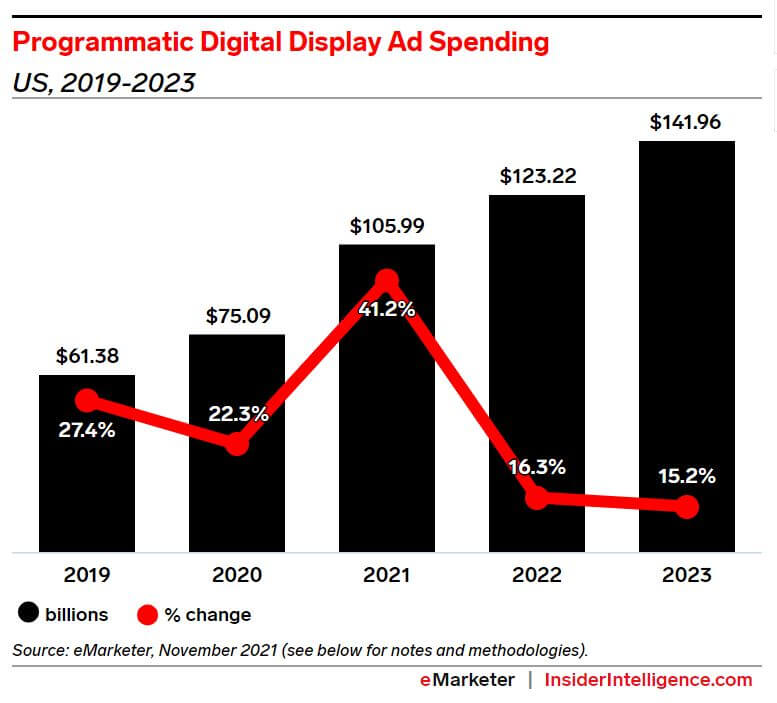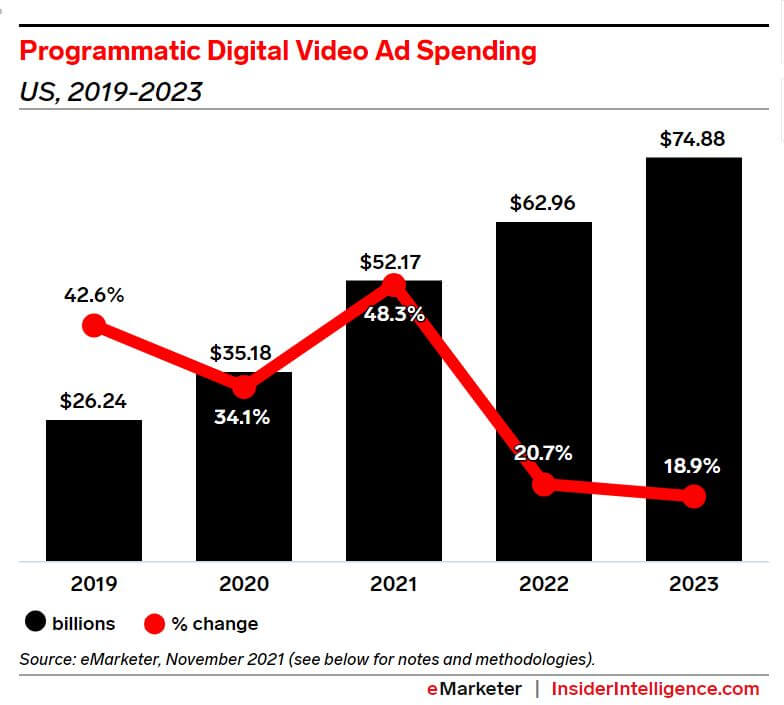
This post was updated on May 16, 2022.
If you’re new to programmatic advertising and want to learn more about it, here’s probably the reason why: everyone seems to be doing it. Programmatic display advertising spend in the US is skyrocketing, jumping from $106 billion in 2021 to an expected almost $142 billion in 2023.

Like many advertisers today, you are keen to get into the fray of programmatic, but not quite sure where to start. After all, ‘programmatic advertising’ sounds so tech-y, another item on the long list of digital tools and tactics that you must keep up to speed with. But make no mistake, as adtech gets more sophisticated, the industry is heading towards a programmatic future – faster, more efficient, and always performance driven.
That’s why we put together this blog post, your introductory guide to programmatic advertising that really, truly starts with the basics. Once you’ve got a handle on the concepts behind programmatic, make sure to download the playbook and learn about the programmatic products you can access on Outbrain. Meanwhile, keep reading below and start brushing up on your programmatic skills.
Intro Guide to Programmatic Advertising
In order to understand programmatic advertising, it’s helpful to go back to the basics of ad buying. And what better place to start than the award-winning TV series Mad Men, centered around the fictional Madison Avenue ad agency, Sterling Cooper, when copywriter Paul explains the media buying department to new secretary Peggy.
“That’s the whole shakedown actually. They don’t sell ideas or campaigns or jingles. They sell media at a 15% markup.”
Mad Men: Ad Agency Walkthrough
Of course, there is a whole lot more to advertising than just buying media space. But there’s no doubt that ad buying is – and has always been – the key to the business.
No matter how creative or brilliant the ad, placement is the only way it’s going to be seen by the intended audience. Therefore, buying the best ad space at the best price and targeting it to the right audience, is the whole shakedown, really.
Fast forward to the 2020s, and there’s a new media buying kid on the block: programmatic advertising.
Automated, complex and computerized, it’s a far cry from ad buying in the Mad Men era. Let’s take a look at what is programmatic advertising, and how it works.
What is programmatic advertising?
Programmatic advertising is defined as the automated buying and selling of online advertising space. But actually, it’s much more than that.
The market for digital advertising space is run by ad exchanges, who operate computerized auctions that bring together both parties of the transaction:
- Advertisers, who want to buy ad space on the internet.
- Publishers, the website owners with digital space to sell.
Programmatic advertising takes the entire process to a new level. It uses algorithmic software that handles the sale and placement of digital ad impressions via ad exchange platforms – in a fraction of a second.
Programmatic also incorporates traffic data and online targeting methods to serve impressions more accurately, efficiently and at scale, which means better ROI for advertisers and publishers alike.
How does programmatic ad buying work?
Here’s the programmatic buying flow in a nutshell:
- A person clicks on a website
- The website owner puts the ad impression up for auction (SSP)
- Advertisers offer bids for the impression (DSP)
- The highest bidder wins the ad impression
- The ad is served on the website to the user
- The user (hopefully!) clicks on the ad and converts
Despite the many steps involved, this entire process happens in an instant. What’s more, the competing bids are calculated by algorithms and a host of analytics to automatically determine the most cost-effective bid.
For example, if the user who clicked on the website is a strong potential customer for your ad, based on their historical surfing data and online profile, the bid served for your impression will be higher.
What is a Demand-Side Platform (DSP)?
In every purchase of online ad space, there are two sides: the buyers (advertisers) and the sellers (publishers). Each side uses a computerized platform to facilitate the transaction on the ad exchange: publishers use Supply-Side Platforms (SSP) and advertisers use Demand-Side Platforms (DSP).
A DSP enables advertisers to purchase ad impressions on publisher websites, made available via ad exchanges and networks. It also enables advertisers to target certain audiences via data such as location, age, previous online behavior and more. The advertiser enters bids for ad space via the DSP, and the DSP automatically allocates ad impressions to abased on the advertiser’s bid price and audience targeting preferences.
Types of programmatic advertising
In the world of digital media buying, you’ve probably come across the concept of Real-Time Bidding, or RTB.
RTB, is just one type of programmatic advertising. While static auctions for online ad space involve the purchase of thousands of impressions upfront, RTB enables bidding for individual ad impressions, which makes it much more focused than bulk ad buying.
Besides RTB, programmatic also includes other advanced forms of automated ad buying, such as “programmatic direct”, when an advertiser buys guaranteed ad impressions on specific websites or from selected publishers. With programmatic direct buying, advertisers can be assured ad space on specific publisher sites, however there is less capability to finetune audience targeting.
Many programmatic buyers use both RTB and programmatic direct to ensure the best digital ad placement mix.
What are the benefits of programmatic advertising?
Programmatic advertising provides a host of benefits that were unimaginable just five or ten years ago. And it is getting more sophisticated as new ad tech comes onto the scene. Here are some of the key advantages of programmatic advertising…
- Reach
Programmatic advertising supports multiple ad exchanges and networks, which gives advertisers access to far more ad space on thousands of websites at once. Advertisers can advertise at scale at affordable prices and with no extra work.
- Transparency
Programmatic advertising gives advertisers and publishers real-time access to data about ad placements and activity, which helps to maximize transparency. The next step is achieving transparency in programmatic costs, which is a key issue facing the industry.
- Driving real engagement
Programmatic advertising goes beyond impressions. It supports advanced targeting, such as contextual targeting, interest targeting, and lookalikes, to help advertisers reach high-quality audiences at scale and maximize their CTRs and conversion rates.
- Data insights & reporting in real-time
Programmatic exchanges provide access to real-time data and advanced reporting about ad placements and performance, so advertisers and publishers can optimize campaigns quickly and accurately at scale.
- Relevancy
Programmatic ad buying gives advertisers access to a massive ad inventory across multiple ad exchanges and networks with a click of the mouse, including premium inventory and private marketplaces with high-quality traffic. With programmatic, advertisers can make sure to maximize the relevancy of their ads for specific targeted audiences and improve ROAS.
Is programmatic the future of marketing?
When it comes to programmatic, the future is already here. Programmatic advertising spend is increasing every year, and the remarkable growth extends beyond display ads to native advertising, mobile advertising and video advertising. By 2023, programmatic video advertising spend in the US is forecast to reach close to $75 billion.

And it’s not just in the US – programmatic ad spend in Europe was expected to reach nearly $30 billion in 2021, an increase of close to $5 billion compared to the previous year.
How much does programmatic advertising cost?
Programmatic advertising works on a CPM (Cost Per Mille), or Cost Per Impression, model. CPM is the price per 1000 ad impressions that appear on a website. Programmatic ads CPM is usually believed to cost somewhere between $0.50 and $2. Certainly, programmatic CPM is far cheaper than other platforms, such as social media networks where CPM can go as high as an average $6-$7.
In fact, the cost of programmatic advertising depends on multiple factors and parameters. Check out this calculator from the IAB to help calculate programmatic fees.
How to integrate programmatic into your marketing mix?
Although programmatic spend is on the up and up, for many digital marketers, lack of understanding of the way programmatic advertising works is a huge hindrance. As the use of programmatic ad tech overtakes the traditional advertising model, the importance of building strong advertiser-publisher relationships is declining and the need to gain technical knowledge of programmatic technology increases.
Due to the reach and scale of programmatic advertising, it’s a very effective way to boost brand awareness among high-volume audiences. If you are focusing an ad campaign on the consideration/ awareness stage, you might want to consider using programmatic to spread your message. With the help of more advanced programmatic ad formats, like native ads and video ads, you can engage audiences even more effectively.
How to get started with programmatic?
For newbies to programmatic advertising, the best place to begin is by getting educated. Watch webinars, listen to podcasts about programmatic, and network with colleagues about best practices.
Once ready to get started, begin with developing your audience personas, advertising strategy, and KPIs. This will help you in your research about which programmatic ad exchanges and ad networks are right for you.
And remember to check out the Playbook where you’ll find out how to use programmatic advertising on the Outbrain native ad network.